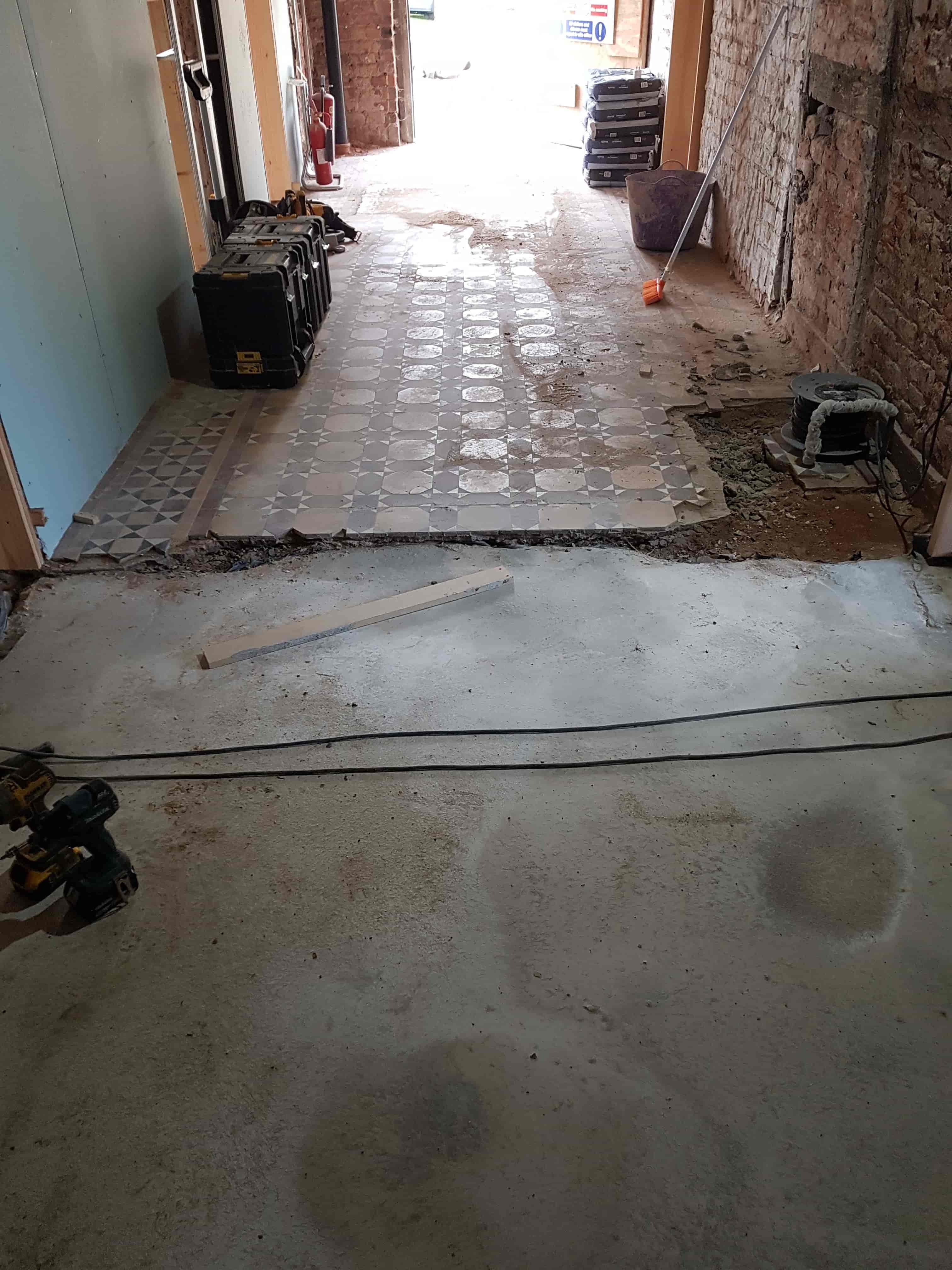Earlier this year were contacted by the The Vintage Floor company who have supplied me with reclaimed tiles in the past to see if we could help one of their customers restore a Victorian floor at Aston Park House in Great Budworth. A section of flooring in the mansion house had been ripped out by a property developer along with most of the other features in the building. According to Cheshire Live news the developer was taken to court and fined for the “reckless vandalism” of a rare Grade II listed building.

The property dates to 1715 and at one time was part of the nearby Arley Hall Estate which has been used for many film locations including Peaky Blinders and War of the Worlds. English Heritage were now keeping a close eye on the renovation work, so needless to say the standard had to be high.
On the first day of work a person from English Heritage met me with old plans of the floor and how it was to be restored. Fortunately, half the floor was still there so that section just needed a good clean and seal, but there was a twelve-foot section of the floor missing which needed to be replaced to English Heritage standards.
 |
 |
Rebuilding a Victorian Tiled Hallway Floor
English Heritage had arranged to have a new sub-base installed so I was able to get straight onto tiling the floor. I used a modern flexible adhesive to lay the tiles which alone took two weeks as there were 2,450 tiles of different sizes. Keeping the tiles butted up to each other level and smooth and following the correct pattern is meticulous work. Once the new tiles were laid it was left for three days to set before I returned to grout the floor. With part one of the project done English Heritage returned to check my work which was a nerve-racking experience.
 |
 |
English Heritage has specified that the floor needed to be levelled so to ensure the tiles were completely flat I applied a system that Tile Doctor use called Milling. This involves the application of a coarse 200-grit DRB pad to take out any lippage and flatten the tiles. DRB stands for Diamond Resin Block which refers to the segments in the pad that do the heavy lifting of milling the tiles. The pads are applied using a rotary machine which is fitted with extra weights to make better contact with the tile and is run at a slow speed. Water is used as a lubricant and the fine slurry generated is removed with a wet vacuum.
Deep Cleaning a Victorian Tiled Hallway Floor
Next step was to get both floors clean using a 200-grit pad (without segments) followed with a set of burnishing pads from 400, 800 and finally 1500-grit to restore the surface. Again, each pad is applied with water for lubrication and is rinsed and extracted after each pad. This process really gets the floor clean and reduces any noticeable difference between the new and old floors.
After completing the burnishing, the floor was treated to an acid wash using Tile Doctor Acid Gel. This is applied to the floor and left to soak for ten minutes before being rinsed off with water and extracted with a wet vacuum. Old floors don’t have a damp proof membrane so this neutralises any efflorescent salts in the tile which could cause a problem later, it also ensures grout smears are removed. The floor was then left to dry out for seven days.
Sealing a Victorian Tiled Hallway Floor
On return we tested the floor to check it was dry enough to seal, this is important as any moisture in the tile can affect the sealer leading to an inconsistent finish. One coat of Tile Doctor Colour Grow was applied to start, this is a colour intensifying breathable impregnator that soaks into the tile improving its appearance and adding protection from within. Any excess sealant was removed by wiping the floor with a microfibre cloth and then it was left to dry for an hour.
We then applied four coats of Tile Doctor Seal and Go Extra which is an acrylic sealer and breathable. This is an important feature when choosing a sealer for old floors where moisture needs to be allowed to rise through the tile, otherwise it can become trapped under the floor and reach out to the walls causing rising damp.

We returned two days later for a final inspection with English Heritage which thankfully we got the nod that the floor had passed!

Source: Victorian Tiling Restoration Service in Great Budworth
Never use a strong cleaning product or steam cleaner for the regular cleaning of sealed tiles as this will reduce the life of the sealer. We recommend using a specialist tile cleaning product such as Tile Doctor Neutral Tile Cleaner for the regular cleaning of sealed Victorian tiles, if you do use another product always read the label first, most supermarket tile cleaners are only suitable for use on Shower or ceramic tiles.